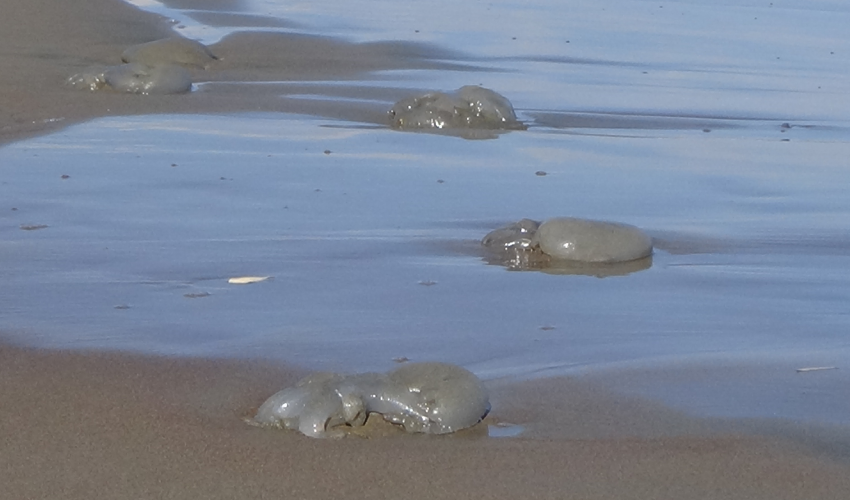Surge in nomad jellyfish populations threatens Mediterranean fishing industry
Turkish scientists are warning that the rise in nomad jellyfish populations due to global warming is threatening the fishing industry and other sectors reliant on clear waters along the Mediterranean coast

Turkish scientists warn that the rise in the nomad jellyfish population due to global warming could hurt the fishing industry along the Mediterranean coast and other industries that depend on clear waters.
Nomad jellyfish, typically seen in summer, showed an unusual increase this February and March in Mersin, a key tourism and fishing hub in Türkiye's Eastern Mediterranean.
The detection of numerous live and dead jellyfish on the coasts prompted experts to take action.
The Institute of Marine Sciences at Türkiye’s Middle East Technical University (METU), based in the capital Ankara, and Mersin University's Fisheries Faculty have stepped up their research on the Red Sea-dwelling species Rhopilema Nomadica, also known as the nomad jellyfish.
Both underwater and surface studies have looked into the reasons for jellyfish population growth and its effects on other species.
Global warming fueling population ‘explosion’
Ahmet Kideys of the Institute of Marine Sciences told Anadolu that the nomad jellyfish is an invasive species.
“We call their presence in the seas an 'explosion.' The reason for their explosion so early is undoubtedly global warming,” Kideys said.

The density of nomad jellyfish hurts the marine ecosystem at large, he added.
“Nomad jellyfish are not a species native to the Mediterranean. They come from the Indian Ocean through the Red Sea. We first detected them in 1995. After that year, they started to increase and be seen earlier every day.
“These are species that love warmth. Before we used to see them in the summer months, but now we started to see them in March. Their numbers are incredibly high. This is not good for the ecosystem. We are studying them,” he said.
He added that in one study, approximately 400 jellyfish were detected along an 800-meter (0.5-mile) coastline, and their diameter reached up to 90 centimeters (35.4 inches).
Kideys also said the population has spread along the Mediterranean coasts.
“As we go toward Iskenderun (in Hatay, the Turkish province farthest south), we see even more. As we go west, it decreases a bit. Nevertheless, our colleagues from Antalya are also doing research. They are very busy at the moment. There are more jellyfish than fish in the sea.”
Fewer fish to catch in Mediterranean
Kideys underlined that this large number of jellyfish is likely to hurt fishing.
“Jellyfish feed on food that fish would otherwise consume, such as plankton, very small organisms. My prediction is that unfortunately, there will be far fewer fish to catch in the Mediterranean next year,” he explained.
“Fishermen cast nets and trawls to fish. This (jellyfish) species will be predominant in the majority of the nets. We believe that it is a very harmful and invasive species that will negatively affect fishing. It will compete with other species in the ecosystem and cause their numbers to decrease.
“It also directly harms people. The tourism season hasn’t opened yet, but people will start swimming in the sea in a few months. Since they are the same color as the sea, you often don't see them. Especially the smaller ones can sting upon contact. They have the potential to create allergies and other health problems,” he warned.
Kideys also said it would be beneficial for local governments to work in areas where jellyfish are abundant and stressed the need to warn the public about the species.

‘Fishing nets filled with jellyfish’
Nomad jellyfish form a large population along the coasts of the island of Rhodes along with Israel, Lebanon, and other parts of the Eastern Mediterranean, said Deniz Ayas of the Middle East Technical University Fisheries Faculty.
The proliferation of the species directly affects fishing, he said.
“Especially in the eastern part of Mersin, serious problems related to fishing have started emerging. Nets used in longline fishing are completely covered with this species, and fishermen even have difficulty pulling their nets out of the sea. There are very serious numbers in the section up to 300 fathoms (548.6 meters) deep. When fishermen lift the nets, the boats are filled with nomad jellyfish.”
Ayas also said the rise in seawater temperature is pushing up the species’ population.
“The size of the population of this species in the sea is growing every day,” he said.
“The main reasons include more food in the environment and the withdrawal of pelagic (open sea) fish because a very large food mass remains for them. The plankton that fish can’t eat is consumed by these species, and very large schools are formed. We’re constantly doing field studies related to fishing. We recently did trawling in Karatas, Adana. There was also a dense population there. There are very large schools in the entire coastal band up to 300 fathoms (548.6 meters) deep.”
Effects on tourism
Going into the sea in areas where jellyfish are present is unwise, Ayas said.
“This species has the potential to affect tourism in the Eastern Mediterranean. We’ve been monitoring this species for about 12 years. Generally, the density on the beaches falls at the beginning of April, but there is a possibility of them being present until June or July. We hope not to see this species starting around April.”
Too many jellyfish could mean the seas are no longer friendly for tourists or anyone wanting to take a dip.
Source: AA







